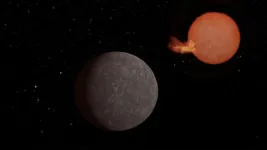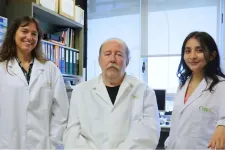(Press-News.org)
The SPECULOOS project, led by the astronomer Michaël Gillon from the University of Liège, has just discovered a new Earth-sized exoplanet around SPECULOOS-3, an "ultracool dwarf" star as small as Jupiter, twice as cold as our Sun, and located 55 light-years from Earth. After the famous TRAPPIST-1, SPECULOOS 3 is the second planetary system discovered around this type of star.
Ultra-cool dwarf stars are the least massive stars in our Universe, similar in size to Jupiter, more than twice as cold, ten times less massive and a hundred times less luminous than our Sun. Their lifespan is over a hundred times longer than that of our star, and they will be the last stars to shine when the Universe becomes cold and dark. Although they are far more common in the Cosmos than Sun-like stars, ultra-cool dwarf stars are still poorly understood due to their low luminosity. In particular, very little is known about their planets, even though they represent a significant fraction of the planetary population of our Milky Way.
It's against this backdrop that the SPECULOOS consortium, led by the University of Liège, has just announced the discovery of a new Earth-sized planet orbiting a nearby ultra-cool dwarf star. The SPECULOOS-3 b exoplanet lies around 55 light-years from Earth (which is very close on a cosmic scale! Our galaxy, the Milky Way, stretches over 100,000 light-years). SPECULOOS 3 is only the second planetary system to be discovered around this type of star: "SPECULOOS-3 b is practically the same size as our planet," explains the astronomer Michaël Gillon, first author of the article published in Nature Astronomy. A year, i.e. an orbit around the star, lasts around 17 hours. Days and nights, on the other hand, should never end. We believe that the planet rotates synchronously, so that the same side, called the day side, always faces the star, just like the Moon does for the Earth. On the other hand, the night side hand, would be locked in endless darkness."
The SPECULOOS (Search for Planets EClipsing ULtra-cOOl Stars) project, initiated and led by astronomer Michaël Gillon, has been specially designed to search for exoplanets around the nearest ultra-cold dwarf stars. These stars are scattered across the sky, so you must observe them one by one, over a period of weeks, to have a good chance of detecting transiting planets," continues the researcher. This requires a dedicated network of professional robotic telescopes." This is the concept behind SPECULOOS, jointly run by the Universities of Liège, Cambridge, Birmingham, Berne, MIT and ETH Zürich.
"We designed SPECULOOS specifically to observe nearby ultra-cool dwarf stars in search of rocky planets that lend themselves well to detailed studies," comments Laetitia Delrez, astronomer at the University of Liège. In 2017, our SPECULOOS prototype using the TRAPPIST telescope discovered the famous TRAPPIST-1 system made up of seven Earth-sized planets, including several potentially habitable ones. This was an excellent start!"
The SPECULOOS-3 star is more than twice as cold as our sun, with an average temperature of around 2,600°C. Due to its hyper-short orbit, the planet receives almost sixteen times more energy per second than the Earth does from the Sun and is therefore literally bombarded with high-energy radiation. "In such an environment, the presence of an atmosphere around the planet is highly unlikely," says Julien de Wit, MIT professor and co-director of the SPECULOOS Northern Observatory and its Artemis telescope, co-developed by the University of Liège and MIT, and the mainstay of this discovery. The fact that this planet has no atmosphere could be a plus in several respects. For example, it could enable us to learn a great deal about ultra-cool dwarf stars, which in turn will make possible more in-depth studies of their potentially habitable planets."
SPECULOOS-3 b is proving to be an excellent target for the JWST space telescope, to be launched in 2021, whose data will revolutionize our vision of the Universe. "With the JWST, we could even study the mineralogy of the planet's surface!" enthuses Elsa Ducrot, a former researcher at the University of Liège now based at Paris Observatory.
"This discovery demonstrates the ability of our SPECULOOS-North observatory to detect Earth-sized exoplanets suitable for detailed study. And this is just the beginning! Thanks to the financial support of the Walloon Region and the University of Liège, two new telescopes, Orion and Apollo, will soon join Artemis on the plateau of the Teide volcano in Tenerife, to speed up the hunt for these fascinating planets" concludes Michaël Gillon.
END
Two Cancer Research UK-funded studies from Oxford Population Health have discovered proteins in the blood that could warn people of cancer more than seven years before it is diagnosed.
Scientists identified 618 proteins linked to 19 different types of cancer, including 107 proteins in a group of people who blood was collected at least seven years before diagnosis.
The team have discovered that these proteins could be involved at the very earliest stages of cancer, where it could be prevented.
They ...
A new, Earth-sized planet orbiting an ultra-cool red dwarf star, has been detected by an international team of astronomers – just 55 light years away.
The planet is only the second of its kind to be discovered around this type of star. Called SPECULOOS-3 b, it takes around 17 hours to complete an orbit of the star which is more than twice as cold as our sun, as well as ten times less massive and a hundred times less luminous.
Days and nights on SPECULOOS-3 b seem to be endless: the planet is likely to be tidally locked, so the same side – the ‘dayside’ – always faces the star in a relationship similar to our moon and Earth.
The ...
A recent study led by the Molecular and Cellular Neurobiotechnology group at the Institute for Bioengineering of Catalonia (IBEC) and the University of Barcelona has identified a new biomarker for Alzheimer's disease in asymptomatic stages of the disease. The molecule is miR-519a-3p, a microRNA directly linked to the expression of the cellular prion protein (PrPC), which is deregulated in people suffering from some neurodegenerative diseases such as Alzheimer's.
The search for biomarkers that are stable and easily detectable in biofluids, ...
New research has shed light in the complex interplay between cell proteins, and how they impact on neurons in neurodevelopmental disorders and Alzheimer’s disease.
A new study led by the University of Exeter and published in Royal Society Open Biology has discovered the key role that the protein Contactin-4 (encoded by the gene CNTN4) plays in shaping neurons.
The researchers began studying CNTN4 because it was known to have a role in autism, but its functional roles were not well understood. The team explored how CNTN4 functions within the brain, particularly its interactions with proteins involved in neurodegenerative diseases like Alzheimer's ...
Lifespan caps for passenger vehicles have limited effect on reducing greenhouse gas emissions and could drive up costs and material use finds a new study published in Environmental Research: Infrastructure and Sustainability. The research shows that although Light-Duty vehicles (LDVs) contribute 17% to the annual greenhouse gas emissions in the United States, imposing a 15-year lifespan cap on LDV fleets under a business-as-usual scenario will not lead to any meaningful reductions in GHG emissions.
To combat delayed uptake of Electric Vehicles (EVs), some have argued for limits on the vehicle’s ...
Paris, France, 14-17 May 2024. The Course Directors have selected 3 major Late Breaking Trials (LBTs) that will be presented for the first time during the 2024 edition of EuroPCR. These trials were selected on account of their design, outcomes and potential to influence daily clinical practice. Among them is the NOTION-2 randomised clinical trial (RCT).
Background
Evidence comparing the use of transcatheter aortic valve implantation (TAVI) and surgical aortic valve replacement (SAVR) in low-risk patients with aortic ...
Paris, France, 14-17 May 2024. The Course Directors have selected 3 major Late Breaking Trials (LBTs) that will be presented for the first time during the 2024 edition of EuroPCR. These trials were selected on account of their design, outcomes and potential to influence daily clinical practice. Among them is the REC-CAGEFREE II trial.
Background and methods
The REC-CAGEFREE II trial is an open-label, investigator-initiated, non-inferiority, multicentre randomised trial comparing stepwise de-escalation of dual antiplatelet therapy (DAPT) with standard DAPT in patients with acute coronary syndrome (ACS) treated with paclitaxel-coated balloons (PCB). Eligible ...
Paris, France, 14-17 May 2024. The Course Directors have selected 3 major Late Breaking Trials (LBTs) that will be presented for the first time during the 2024 edition of EuroPCR. These trials were selected on account of their design, outcomes and potential to influence daily clinical practice. Among them is the LANDMARK trial.
Background and Methods
Key randomized controlled trials have compared surgical aortic valve replacement (SAVR) with transcatheter aortic valve implantation (TAVI) using one of two commercially available transcatheter heart valves (THVs) - ...
New research published in Aging Cell provides insights into how exercise may help to prevent or slow cognitive decline during aging.
For the study, investigators assessed the expression of genes in individual cells in the brains of mice. The team found that exercise has a significant impact on gene expression in microglia, the immune cells of the central nervous system that support brain function. Specifically, the group found that exercise reverts the gene expression patterns of aged microglia to patterns seen in young microglia.
Treatments that depleted ...
Gelatinous zooplankton, including jellyfish and other diverse, nearly transparent organisms, play important roles in marine ecosystems. Climate change is expected to significantly alter their populations and distributions. New research published in Limnology and Oceanography examines their fate in the Arctic Ocean, one of the fastest warming oceans on Earth.
Investigators coupled three-dimensional species distribution models with oceanographic variables from the Coupled Model Intercomparison Project Phase 6. The analyses allowed the team to identify gelatinous ...



